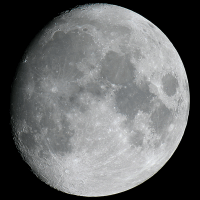Moon
From Gwn
| Earth's Moon | |

| |
| Discovered: | Always known to humanity. |
| Named After: | Colloquial Term |
| Relative Size: | Planet Standard |
| Satellites: | None |
The Moon is Earth's only natural satellite. It has no formal name other than "the Moon", although it is occasionally called Luna (Latin: moon) to distinguish it from the generic term "moon" (referring to any of the various natural satellites of other planets). Its symbol is a crescent (☽). The related adjective for the Moon is lunar (from the Latin root).
Contents |
History
The Moon has been the subject of many works of art and literature and the inspiration for countless others. A 5,000 year old rock carving at Knowth, Ireland may represent the Moon, which would be the earliest depiction discovered. In many prehistoric and ancient cultures, the Moon was thought to be a deity or other supernatural phenomenon, and astrological views of the Moon continue to be propagated today.
In 1609, Galileo Galilei drew one of the first telescopic drawings of the Moon in his book Sidereus Nuncius and noted that it was not smooth but had mountains and craters. Later in the 17th century, Giovanni Battista Riccioli and Francesco Maria Grimaldi drew a map of the Moon and gave many craters the names they still have today.
On maps, the dark parts of the Moon's surface were called maria (singular mare) or seas, and the light parts were called terrae or continents. The possibility that the Moon could contain vegetation and be inhabited by selenites was seriously considered by some major astronomers even into the first decades of the 19th century. The contrast between the brighter highlands and darker maria create the patterns seen by different cultures as the Man in the Moon, the rabbit and the buffalo, amongst others.
Exploration
y
Modern Uses
y
The fracturing of the Moon
AC 275
Meaning of the Name
The English word "earth" has cognates in many modern and ancient languages. Examples in modern tongues include aarde in Afrikaans and Dutch, and Erde in German. The root has cognates in extinct languages such as ertha in Old Saxon and ert (meaning "ground") in Middle Irish, derived from the Old English eorðe. All of these words derive from the Proto-Indo-European base *er-.
Words for Earth in other languages include: Terre (French), पृथ्वी pr̥thvī (Sanskrit), Maa (Finnish and Estonian), Pământ (Romanian), Föld (Hungarian), Ziemia (Polish), Zemlja (Russian and Serbian), Zemya Земя (Bulgarian), Tierra (Spanish), Terra (Italian), Diqiu (Mandarin), Deiqao (Cantonese), Jigu (Korean), Bumi (Malay), Chikyuu (Japanese), Jorden (Danish, Norwegian, Swedish), כדור הארץ (Hebrew), Bhoomi (Telugu), Gi, Choma (Greek), Dunia (Swahili), Âlem, Dünya الْمَسْكُونَة (Arabic), Dinê (Kurdish), Ergir երկիր (Armenian), Jehun, Zamin (Persian), and Acun, Yeryüzü, Yerküre (Turkish).
